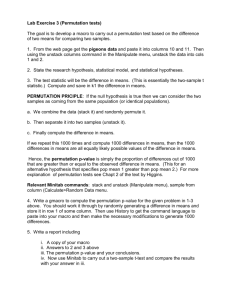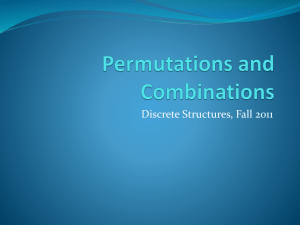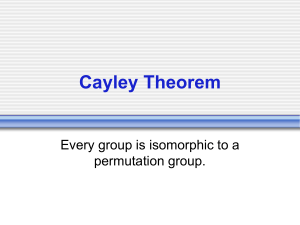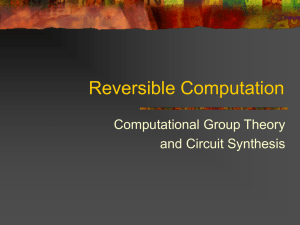Permutation tests for independence in general r x c tables
advertisement
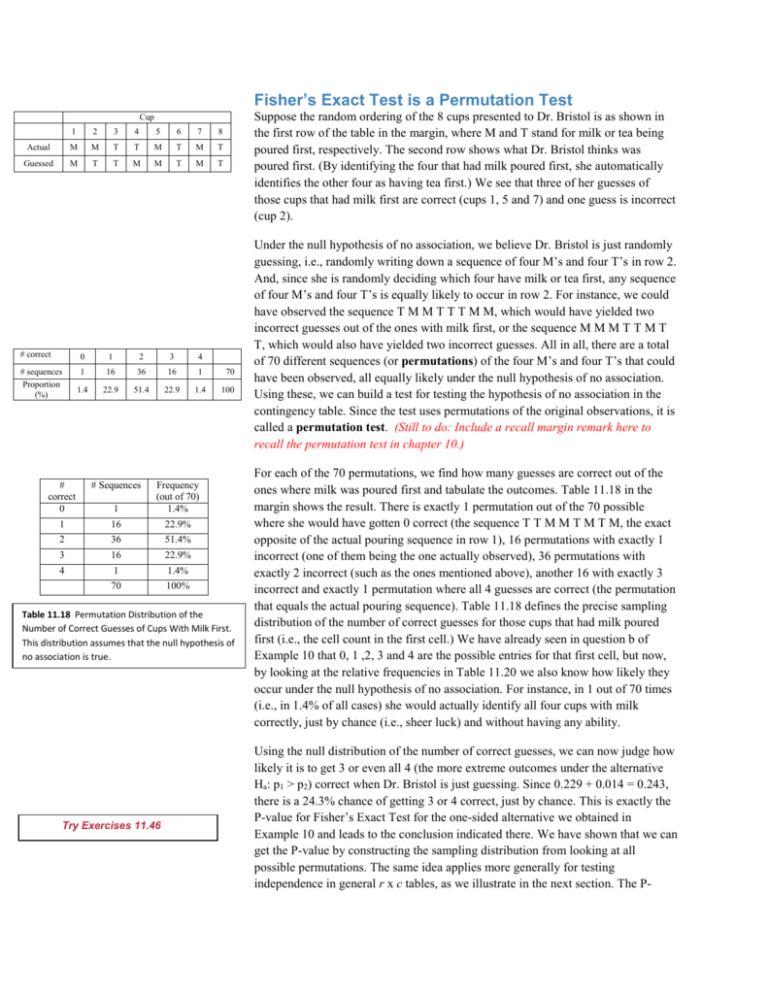
Fisher’s Exact Test is a Permutation Test Suppose the random ordering of the 8 cups presented to Dr. Bristol is as shown in the first row of the table in the margin, where M and T stand for milk or tea being poured first, respectively. The second row shows what Dr. Bristol thinks was poured first. (By identifying the four that had milk poured first, she automatically identifies the other four as having tea first.) We see that three of her guesses of those cups that had milk first are correct (cups 1, 5 and 7) and one guess is incorrect (cup 2). Cup 1 2 3 4 5 6 7 8 Actual M M T T M T M T Guessed M T T M M T M T # correct 0 1 2 3 4 # sequences Proportion (%) 1 16 36 16 1 70 1.4 22.9 51.4 22.9 1.4 100 # correct 0 # Sequences 1 Frequency (out of 70) 1.4% 1 16 22.9% 2 36 51.4% 3 16 22.9% 4 1 1.4% 70 100% Table 11.18 Permutation Distribution of the Number of Correct Guesses of Cups With Milk First. This distribution assumes that the null hypothesis of no association is true. Try Exercises 11.46 Under the null hypothesis of no association, we believe Dr. Bristol is just randomly guessing, i.e., randomly writing down a sequence of four M’s and four T’s in row 2. And, since she is randomly deciding which four have milk or tea first, any sequence of four M’s and four T’s is equally likely to occur in row 2. For instance, we could have observed the sequence T M M T T T M M, which would have yielded two incorrect guesses out of the ones with milk first, or the sequence M M M T T M T T, which would also have yielded two incorrect guesses. All in all, there are a total of 70 different sequences (or permutations) of the four M’s and four T’s that could have been observed, all equally likely under the null hypothesis of no association. Using these, we can build a test for testing the hypothesis of no association in the contingency table. Since the test uses permutations of the original observations, it is called a permutation test. (Still to do: Include a recall margin remark here to recall the permutation test in chapter 10.) For each of the 70 permutations, we find how many guesses are correct out of the ones where milk was poured first and tabulate the outcomes. Table 11.18 in the margin shows the result. There is exactly 1 permutation out of the 70 possible where she would have gotten 0 correct (the sequence T T M M T M T M, the exact opposite of the actual pouring sequence in row 1), 16 permutations with exactly 1 incorrect (one of them being the one actually observed), 36 permutations with exactly 2 incorrect (such as the ones mentioned above), another 16 with exactly 3 incorrect and exactly 1 permutation where all 4 guesses are correct (the permutation that equals the actual pouring sequence). Table 11.18 defines the precise sampling distribution of the number of correct guesses for those cups that had milk poured first (i.e., the cell count in the first cell.) We have already seen in question b of Example 10 that 0, 1 ,2, 3 and 4 are the possible entries for that first cell, but now, by looking at the relative frequencies in Table 11.20 we also know how likely they occur under the null hypothesis of no association. For instance, in 1 out of 70 times (i.e., in 1.4% of all cases) she would actually identify all four cups with milk correctly, just by chance (i.e., sheer luck) and without having any ability. Using the null distribution of the number of correct guesses, we can now judge how likely it is to get 3 or even all 4 (the more extreme outcomes under the alternative Ha: p1 > p2) correct when Dr. Bristol is just guessing. Since 0.229 + 0.014 = 0.243, there is a 24.3% chance of getting 3 or 4 correct, just by chance. This is exactly the P-value for Fisher’s Exact Test for the one-sided alternative we obtained in Example 10 and leads to the conclusion indicated there. We have shown that we can get the P-value by constructing the sampling distribution from looking at all possible permutations. The same idea applies more generally for testing independence in general r x c tables, as we illustrate in the next section. The P- value is called an exact P-value because it uses the exact, not approximate, sampling distribution. Permutation Test for Independence or Homogeneity in General r x c Tables Recall From Section 11.2, X2 is a summary measure of the differences between observed and expected (under independence) cell counts. The larger X2, the stronger the evidence for an association. Recall The chi-squared distribution is only appropriate to use when all expected cell counts are larger than 5. See Section 11.2. The same procedure of a permutation test can be extended to general r x c tables. The only difference to the 2 x 2 case is that we no longer can use the first cell (the number of correctly identified cups with milk added first) as a test statistic, but need a more general measure for the association. We will use one that we have used all along to test for an association, the chi-squared statistic X2. However, finding the Pvalue under the chi-squared distribution with df = (r-1)(c-1) may no longer be appropriate, because of small cell counts. Instead, we will find its permutation distribution which will let us judge if the observed value of X2 is large or not. The following example illustrates. Example 12: Edward Snowden – Hero or Criminal? (Use Tag: Permutation Test) Picture the Scenario In 2013, Edward Snowden revealed classified material about massive spying activities by the U.S National Security Agency, not only on U.S citizens, but on citizens worldwide. While the U.S. wants to try him in court for breaking several laws, many other countries point out that the activities of the NSA severely violated their privacy laws. In these countries, Snowden is often celebrated as a h. In a 2014 survey at Williams College, 12 U.S. students and 8 international students were asked whether Edward Snowden should be considered a hero, a criminal, or neither. Table 11.19 shows the results, for which X2 = 6.9. We want to test whether these data provide evidence that the opinion on Edward Snowden differs between U.S. and international students at Williams College. The null hypothesis is that the conditional distributions are the same, i.e., homogeneity. Table 11.19 Results from a survey conducted at Williams College on whether Edward Snowden should be considered a hero, a criminal or neither. X2 = 6.9 for this table. Student Status U.S. International Total Opinion on Edward Snowden Hero Criminal Neither 1 9 2 5 2 1 6 11 3 Total 12 8 20 Question to Explore a. Can we use the chi-squared distribution with df=(2-1)(3-1)=2 to find the P-value for X2 = 6.9? b. How can we construct the permutation distribution of X2 under the null hypothesis of homogeneity? Student Status Response 1 2 3 4 5 6 7 8 9 10 11 12 13 14 15 16 17 18 19 20 Int US US US US US US US US Int Int US Int Int Int US Int Int US US Hero Criminal Neither Criminal Hero Criminal Criminal Criminal Criminal Criminal Hero Neither Hero Hero Hero Criminal Criminal Neither Criminal Criminal Permutation of Status Labels US Int US Int US US Int US US Int US US US Int US US Int US Int Int Caption: Original observations for data summarized in Table 11.19. The last row shows one permutation of the original status labels. c. How can we judge whether the observed value of 6.9 is extreme and find the permutation P-value? Think it Through a. Many counts in Table 11.19 are small, leading to expected values that are smaller than 5. For instance, the expected count is 3.6 in the first cell and 1.2 in the last cell. Using the chi-squared distribution may lead to questionable conclusions since it may not approximate the actual sampling distribution well. b. The first three columns of the table in the margin show the raw data from the survey, before summarizing it in Table 11.19. (You can check that there are, for instance, 5 international students with response “Hero”.) Under the null hypothesis of homogeneity, any given response is equally likely to have come from a U.S. student or an international student. For instance, the probability of a student selecting “Hero” does not depend on whether he is from the U.S or international. Then, the status of a student is merely a label that loses its relevance under the null hypothesis. We get a dataset that is equally likely to occur (under the null hypothesis) when we permute these labels. This is similar to the tea tasting experiment, where under the null hypothesis any permutation of the four M’s and four T’s was equally likely to occur. Here, any permutation (or shuffling) of the status labels for the 12 U.S. and 8 international students yields a dataset that is equally likely to occur. The last column in the margin table shows one possible permutation (out of a total of 125,970) of the 12 “US” and 8 “Int” labels. Taken together with the response column, it leads to the cell counts shown in Table 11.20. For instance, with the permuted status labels we now have only 1 international student with response “Hero”. Table 11.20 Contingency table based on the permuted status labels. X2 = 5.9 for this table. Student U.S. International Total Opinion on Edward Snowden Hero Criminal Neither 5 4 3 1 7 0 6 11 3 Total 12 8 20 Table 11.20 has the same row and column margins as the originally observed Table 11.19. (For any permutation, we will still have a total of 12 US and 8 international students, as well as a total of 6 students responding “hero”, 11 students responding “Criminal” and 2 students responding “Neither”.) However, the cell counts in the body of the table differ from the ones in Table 11.19 and yield a chi-squared statistic of X2 = 5.9. A different permutation of the status labels results yet in another table with the same margins but different cell counts. For each table resulting from a permutation of the status labels we compute the chi-squared statistic X2. Note that several permutations can give rise to the same table and hence X2 statistic. For instance, just switching the last two labels for students 19 and 20 (both US students with response “Criminal”) results in the same table (and hence X2 statistic) as the one observed. X2 Freq. (%) 0.3 # Permutat ions 20,790 16.5 Cumulat ive Freq. (%) 16.5 0.4 19,800 15.7 32.2 1.1 14,850 11.8 44.0 1.9 9,900 7.9 51.9 2.4 25,872 20.5 72.4 … … … … 5.9 3,960 3.1 95.9 6.6 990 0.8 96.7 6.9 2,090 1.7 98.4 … … … … 16.5 6 <0.0 100 17.2 3 <0.0 100 125,970 100% 100% Caption: Excerpt of permutation (=sampling) distribution of X2 based on data in Table 11.19. For instance, 9,900 of all 125,970 permutations resulted in X2 = 1.9 or 4,167 (=3.3%) of all permutations result in an X2 as large or larger than 6.9. In Practice When there are too many possible permutations, one simply takes a large random sample (such as 10,000) of them and computes X2for each. The proportion among them with X2 as large or larger is then a very good approximation of the actual permutation P-value. Tabulating all the different values for X2 and how often they arise yields the permutation distribution for X2. This is the sampling distribution of X2 under the null hypothesis. We show an excerpt of it in the margin, while Figure 11.7 shows it graphically. Figure 11.7 Permutation distribution of X2 based on data in Table 11.19. The black dot indicates the observed vale of X2= 6.9. Question: For tables with larger cell counts than Table 11.19, the shape of the permutation distribution is approximately equal to the shape of which distribution? c. How extreme is the observed chi-squared statistic of 6.9? Figure 11.7 already gives us an idea. The observed value is indicated by the black dot and seems to be in the tail of the distribution. To find the permutation P-value, we need to find the proportion of the 125,970 permutations that yielded a chi-squared statistic as large or larger than the observed one. All in all, there are 4,167 permutations that yielded a value for X2 as large or larger than 6.9, for a proportion of 4,167/125,970 = 0.0331. This is the permutation P-value for the chi-squared test. It indicates that there is evidence that the opinion on Edward Snowden differs among U.S. and international students. Insight The permutation approach is valid for any sample size, not just for small cell counts. However, for larger tables and/or large sample sizes it quickly becomes impossible to compute X2 for all possible permutations because there are just too many. In these cases, one simply generates a large number of random permutations and computes the proportion with an X2 value as large or larger than the one observed. This provides a very accurate approximation of the permutation P-value. We may choose this approach even for Table 11.19 above: Randomly generating 10,000 permutations by “shuffling” the status labels 10,000 times yielded 329 tables with an X2 as large or larger than the observed one of 6.9. (Again, note that many of these random shuffles result in identical tables.) This gives an approximate permutation P-value of 329/10000 = 0.0329, close to the actual permutation Pvalue. Try Exercises 11.45 Still to do: The next Activity shows how you can perform the permutation test for your own data online, using a web app that runs in your browser.
